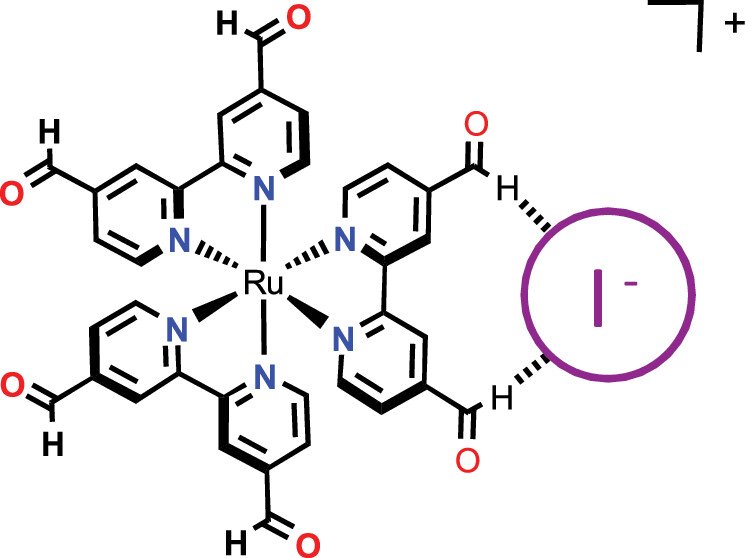Reductive Dynamic and Static Excited State Quenching of a Homoleptic Ruthenium Complex Bearing Aldehyde Groups
A new homoleptic Ru polypyridyl complex bearing two aldehyde groups on each bipyridine ligand, [Ru(dab)3](PF6)2, where dab is 4,4′-dicarbaldehyde-2,2′-bipyridine, was synthesized, characterized, and utilized for iodide photo-oxidation studies. In acetonitrile (CH3CN) solution, the complex displayed an intense metal-to-ligand charge transfer (MLCT) absorbance maximum at 475 nm (ε = 22,000 M–1 cm–1) and an infrared (IR) band at 1712 cm–1 assigned to the pendent aldehyde groups. Visible light excitation in air-saturated solution resulted in room temperature photoluminescence (PL) with a maximum at 675 nm, a quantum yield, ϕPL = 0.048, and an excited state lifetime, το = 440 ns, from which radiative and nonradiative relaxation rate constants were extracted, kr = 9.1 × 104 s–1 and knr = 1.8 × 106 s–1. Pulsed visible light excitation yielded transient UV–vis and IR absorption spectra consistent with an MLCT excited state; relaxation occurred with the maintenance of two isosbestic points in the visible region, and a lifetime that agreed with that measured by time-resolved PL. Cyclic voltammetry studies in a CH3CN solution with 0.1 M TBAPF6 electrolyte revealed a quasi-reversible oxidation, E°(RuIII/II) = +1.25 V vs. Fc+/0, and three sequential one-electron reductions at −1.10, −1.25, and −1.54 V vs. Fc+/0. An excited state reduction potential of E°(Ru*2+/+) = +0.89 V vs. Fc+/0 was estimated with the Rehm–Weller expression. Titration of tetrabutylammonium iodide, TBAI, into a CD3CN solution of [Ru(dab)3](PF6)2 resulted in significant shifts in the aldehyde H atom and 3,3′-biypridyl resonances that were analyzed with a 1:1 equilibrium model, from which Keq = 460 M–1 was extracted, increasing to 5800 M–1 when the solvent was changed to acetone-d6. Iodide titrations resulted in a significant quenching of the [Ru(dab)3]*2+ lifetime and quantum yield in both CH3CN and acetone solvents. In CH3CN, the quenching was mainly dynamic and well described by the Stern–Volmer model, from which a quenching rate constant, kq, of 4.5 × 1010 M–1 s–1 and an equilibrium constant, Keq, of 8.3 × 103 M–1 were obtained. In acetone, the static quenching pathway by iodide was greatly enhanced, with a Keq of 1.2 × 104 M–1 and a higher kq of 9.2 × 1010 M–1 s–1.
Dickenson, J. C.; Grills, D. C.; Polyansky, D. E.; Meyer, G. J. Reductive Dynamic and Static Excited State Quenching of a Homoleptic Ruthenium Complex Bearing Aldehyde Groups, J. Phys. Chem. A. 2024, 128 (21), 4242-4251. https://doi.org/10.1021/acs.jpca.4c01090

